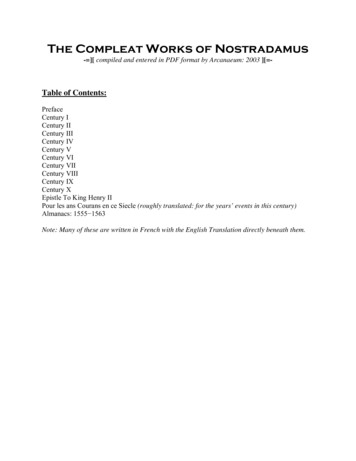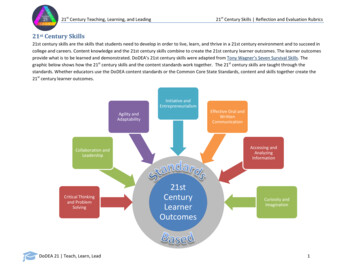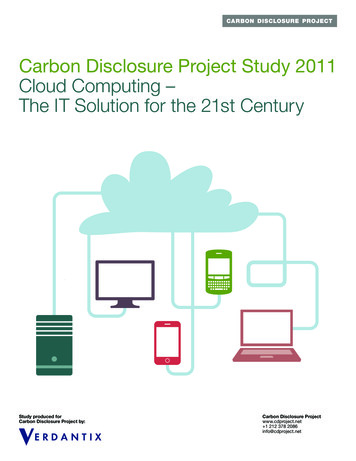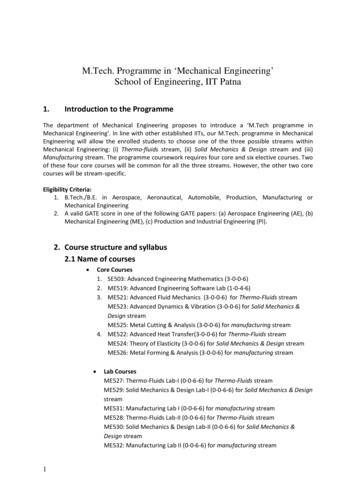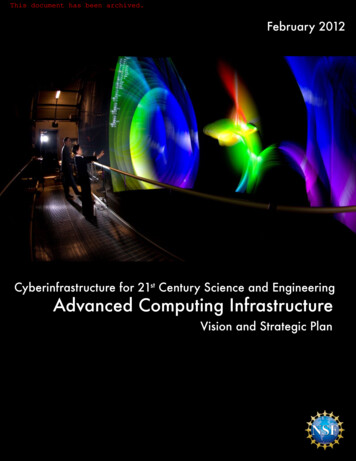
Transcription
This document has been archived.February 2012Cyberinfrastructure for 21st Century Science and EngineeringAdvanced Computing InfrastructureVision and Strategic Plan1
CoVEr ImAgE:As part of the Multimodal Representation of Quantum Mechanics: TheHydrogen Atom project, this image shows people on the bridge of theAlloSphere interacting with the hydrogen atom with spin.Credit: Professor JoAnn Kuchera-Morin, Media Arts and Technology,UCSB; Professor Luca Peliti, University of Naples, Italy; Lance Putnam,Media Arts and Technology, UCSB; photo by Kevin Steele2
CyberinfrastruCture for 21st Century sCienCe and engineering (Cif21)AdvAnced computing infrAstructure strAtegic plAnExECutIVE SummArya comprehensive advanced computing infrastructure thatfacilitates transformational ideas using new paradigms andapproaches.Advanced Computing Infrastructure (ACI) is a key component of the Cyberinfrastructure for 21st Century Scienceand Engineering (CIF21) framework. While CIF21 addressesbroadly the cyberinfrastructure needed by science, engineering, and education communities to tackle complexproblems and issues, ACI specifically focuses on ensuringthese communities have ready access to needed advancedcomputational capabilities. The CIF21 framework includesother complementary, but overlapping components: data,software, campus bridging and cybersecurity, learning andworkforce development, grand challenge communities,computational and data-enabled science and engineering,and scientific instruments (see Figure 1, page 6, for moredetail). Many of these components are beginning to beaddressed by CIF21 programs in fiscal year (FY) 2012, anda process is now underway to develop strategic plans foreach component.The ACI Strategic Plan outlined here seeks to position and support the entire spectrum of NSF-fundedcommunities at the cutting edge of advanced computing technologies, hardware, and software. It also aimsto promote a more complementary, comprehensive, andbalanced portfolio of advanced computing infrastructure and programs for research and education to supportmultidisciplinary computational and data-enabled scienceand engineering that in turn support the entire scientific,engineering, and education community.The vision and strategies articulated here are derivedfrom numerous discussions within NSF and from inputfrom experts in the community such as that from the sixtask force reports of the Advisory Committee for Cyberinfrastructure and from the various directorate advisorycommittees.The National Science Foundation (NSF) has beenan international leader in high- performance computing deployment, application, research, and educationfor almost four decades. With the accelerating pace ofadvances in computing and related technologies, coupledwith the exponential growth and complexity of data forthe science, engineering, and education enterprise, NSFrequires a new vision and strategy to advance and supportThe exponential growth and complexity of data requires a new andqualitatively different approach to data storage, stewardship, management,cybersecurity, distribution and access.Smartphones, tablets, gaming systems and new sensors are changingbusiness, education and research.Credit: ThinkstockCredit: Thinkstock3
ACI VISIon:NSF will be a leader in creating and deploying a comprehensive portfolio of advanced computing infrastructure,programs, and other resources to facilitate cutting-edgefoundational research in computational and data-enabledscience and engineering (CDS&E) and their application toall disciplines. NSF will also build on its leadership roleto promote human capital development and education inCDS&E to benefit all fields of science and engineering.ACI StrAtEgIES:1. Foundational research to fully exploit parallelism andconcurrency through innovations in computationalmodels and languages, mathematics and statistics,algorithms, compilers, operating and run-time systems,middleware, software tools, application frameworks,virtual machines, and advanced hardware.2. Applications research and development in use of highend computing resources in partnerships with scientificdomains, including new computational, mathematicaland statistical modeling, simulation, visualization andanalytic tools, aggressive domain-centric applicationsdevelopment, and deployment of scalable data management systems.Human cranial arterial network includes 65 arteries accounting for everyartery in the brain larger than 1 millimeter in diameter. Using color andscale to show magnitude, this visualization depicts the flow of blood inthe Circle of Willis, a pattern of redundant circulation that maintains thebrain's blood supply in case, part of the circle or a supply artery becomesrestricted or blocked.3. Building, testing, and deploying both sustainableand innovative resources into a collaborative ecosystem that encompasses integration/coordination withCredit: Greg Foss, Pittsburgh Supercomputing Centercampus and regional systems, networks, cloud services, and/or data centers in partnerships with scientificdomains.4. Development of comprehensive education and workforce programs, from deep expertise in computational,mathematical and statistical simulation, modeling,and CDS&E to developing a technical workforce andenabling career paths in science, academia, government, and industry.5. Development and evaluation of transformational andgrand challenge community programs that supportcontemporary complex problem solving by engaginga comprehensive and integrated approach to science,utilizing high-end computing, data, networking, facilities, software, and multidisciplinary expertise acrosscommunities, other government agencies, and international partnerships.IntroduCtIon And BACkgroundInnovative information technologies are transforming the fabric of society and data is the new currency forscience, education, government, and commerce. Highperformance computing (HPC) has played a central role inestablishing the importance of simulation and modeling asthe third pillar of science (theory and experiment being thefirst two), and the growing importance of data is creatingthe fourth pillar.Second-year mechanical engineering technology students Tim Brogan (left)and Ryan Strand used tablet PCs as part of a pneumatics and hydraulicscourse. They were part of a study to determine how use of educationaltechnology might enhance learning, improve interaction and engagementwith classmates and faculty, and decrease withdrawal rates from the course.Credit: Michelle Cometa, University News, Rochester Institute of Technology4
software.” HPC must encompass the ability to efficientlymanipulate and manage vast quantities of data. It mustalso simultaneously address innovations in software andalgorithms, data analytics, statistical techniques, fundamental operating system research, file systems, and innovativedomain-centric applications. The new ACI strategiesdirectly address these issues raised in the PCAST report.Commoditization of both hardware and software iscreating an era of significant disruptions. One disruptionis the changing nature and role of the private sector in thedevelopment of next generation computing and technologies. Advanced computing and data will not be driven byhigh-end science requirements, but instead by millions of 100 devices (e.g., computer games, cell phones, tablets). Microscale margins will drive manufacturers towardvolume, and new technologies will be abandoned if theydo not have a demonstrable share of the market necessary to recoup any development and production costs. Asecond disruption arises from the fact that the ubiquitousavailability of a wide range of technologies will fundamentally change the development of many processes andworkflows, including the type of algorithms and softwarethat must be implemented for research and education. Athird disruption is the emerging transformation of the institutions engaged in the higher education enterprise, as thereis increasingly much less connection between researchersand the physical place of their institutions. This will lead tonew models for data-intensive science that will be organized dynamically around research questions and domains,and will present new challenges to geographically centeredSustainable Harvest, a specialty coffee importer in Portland, Ore., ispartnering to develop applications that will equip farmers in developingcountries with tools to improve crop and harvest tracking and also givefarmers access to educational videos and best practices for improving cropquality. These iPad applications increase traceability and transparencyacross the coffee supply chain.Credit: Sustainable Harvest Coffee ImportersThe continued growth in the number of cores per chipand accelerator-based hybrid systems requires expandedresearch and development efforts in new computerarchitectures, computational models, parallel programming languages, and software development for paralleland distributed systems. It also calls for increased attention to fault-tolerance (resiliency), new operating systems,and run-time systems. Power consumption is currentlya key limitation for all sizes of computers. Similarly,memory bandwidth limitations and increased data movement require significantly greater effort in fundamentalresearch in computer science, mathematical, and statisticalsciences, engineering, and materials science. Multidisciplinary research and use of data require increased levelsof research and development in advanced simulationmethods, coupling of complex models, new algorithms,approaches to software and data integrity and resilience,new data analytic and statistical tools, and data management and sustainability. The growth of data-intensivescience coupled with multidisciplinary collaborationrequires additional effort in existing and new domain-centric applications and tools including software engineering,statistics, and mathematics, broadening use of computational science across all of NSF, and developing the entireCDS&E workforce.In this zoomed-in image of the Antennae Galaxies, the generation of superbright, hot stars that formed when the denser centers of the two spirals firstcollided shine in white-blue.The 2010 President’s Council of Advisors on Scienceand Technology (PCAST) report, “Designing a DigitalFuture,”1 points out that floating point operations persecond (FLOPS) measurements are not definitive measuresfor success in HPC and that it is now important “to conductbasic research in hardware, in hardware/software systems, in algorithms, and in both systems and applicationsFuture stars are growing now, concealed in dark clouds into which opticaltelescopes cannot see. However, ALMA sees through the obscuring dustand traces of these stellar nurseries, many of which show the continuationof the cloud that has been lit pink by a previous generation of newstars. ALMA's millimeter/submillimeter wave test views shown here arerepresented in orange and yellows to contrast with the previous star birthgenerations. (Optical images from HST ACS/WFC.)Credit: (NRAO/AUI/NSF); ALMA (ESO/NAOJ/NRAO); HST (NASA, ESA) and B.Whitmore [STScI]1 PCAST, December 2010, “Designing a Digital Future: Federally FundedResearch and Development in Networking and Information Technology.”5
complex problems and issues addressed by the science,engineering, and education communities. Implementationof the strategies for ACI complements and dovetails withother CIF21 components, including data, software, learning and workforce development, and cybersecurity, aswell as with individual directorate and office research andeducation efforts. CDS&E and grand challenge communities’ activities connect with ACI and all components of theCIF21 strategy. These activities are driven and enabled bya coherent approach to developing these components tomeet the research and science requirements of the nation.research efforts, including traditional campuses.While supercomputers remain a key generator of data,the exponential increase in data from a growing, distributedset of diverse scientific instruments and sensor networksrequires a new and qualitatively different approach todata storage, stewardship, management, cybersecurity,distribution, and access. Not only is the data much larger,more diverse, and more distributed, but the needs for dataanalysis require potentially different computational, mathematical, and statistical approaches and the collaborativenature of research has increased the need for more distributed access.Cyberinfrastructure Framework for the 21st CenturyThis new NSF ACI vision supports both computationaland data-intensive research coming from simulations,scientific instruments, “cloud” computing, and sensors. Itis critical that the newly developed ACI ecosystem accommodates traditional national centers as well as those onuniversity campuses, and include supercomputers, localclusters, storage, and visualization systems that can support far more researchers than in the past. Advancedtechnologies and sustained research in HPC has createda ubiquitous need for advanced digital services across thelandscape, from schools and campuses to research centersand industry. Therefore, NSF’s vision for advanced computing also must expand to focus on the broader base ofCDS&E across multiple domains.1. Foundational research to fully exploit parallelism andconcurrency through innovations in computationalmodels and languages, mathematics, and statistics,algorithms, compilers, operating and run-time systems,middleware, software tools, application frameworks,virtual machines, and advanced hardware. This strategyencompasses:Achieving the ACI vision will advance science andengineering research and education to serve the nation’sneeds for years to come.StrAtEgIC dIrECtIonSThe NSF ACI strategies are part of the larger NSF CIF21framework and are not separate or stand-alone efforts (seeFigure 1). Although this document focuses on the ACIspecific strategies, it is important to note that the completeCIF21 planning involves an integrative approach to support Computational models to enable new and transformative ways of “thinking parallel,” including newabstractions that account for parallelism and concurrency, and support reasoning about the correctnessThe ATLAS detector at CERN.An example of simulated data modeled for the Compact Muon Solenoid(CMS) particle detector on the Large Hadron Collider. Here, following acollision of two protons, a Higgs boson is produced that decays into twojets of hadrons and two electrons.Credit: CERNCredit: TACC6
and parallel performance, consisting of communication, energy costs, resiliency, and security; Programming languages to enable effective expression of parallelism and concurrency at every scale,including new approaches to developing software,handling messaging and shared memory, andimproving programming productivity on parallel anddistributed systems; Disruptive rethinking of the canonical computing“stack” – applications, programming languages,compilers, run-time systems, virtual machine, operating systems, and architecture – in light of parallelismand resource-management challenges and to support optimization across all layers of the stack fromsoftware down to the architecture level; New algorithmic paradigms that promote reasoningabout parallel performance and lead to provable performance guarantees, while allowing algorithms to bemapped onto diverse parallel and distributed environments, and optimizing resource usage includingcompute cycles, communication, input-output (I/O),memory hierarchies, and energy;Scientists studied the interaction of the Deep Water Horizon oil spill andmicrobes in Gulf of Mexico waters.Credit: Luke McKay, University of Georgiafine-grain synchronization, parallel memory systems, and I/O; Research into highly parallel and scalable application-specific and heterogeneous system architectures; Computer software architectures to enable resilientcomputation at a (or the) large scale, including newoperating systems for multicore systems and cloudarchitectures; file systems and data stores for dataintensive computing; run-time systems to manageparallelism, synchronization, communication, scheduling, and energy usage; and compilers to managedebugging, predictability, power consumption, andsecurity; Algorithms and software architectures capable ofhandling both small- and extreme-scale data systemsand data analytics; Fundamental research in mathematical algorithms,statistical theory and methodologies to address thechallenges with massive and distributed data.2. Research and development in the use of high-endcomputing resources in partnerships with scientificdomains, including new computational, mathematical,and statistical modeling, simulation, visualization, andanalytic tools, aggressive domain-centric applicationsdevelopment, and deployment of scalable data management systems. This strategy encompasses: Computer architectures that focus on efficient communication, including interconnection networks, A systematic exploration of next-generation sciencemethods, algorithms, and applications in all disciplines, their computational needs, and their mappingon to potential future architectures and approachesto computing; New algorithms to exploit massively parallel anddistributed platforms, and for data-intensive computational tasks, as well as methods to decomposeexisting serial algorithms into faster combinations ofserial/parallel/distributed computation; Research into highly parallel and scalable application-specific and heterogeneous system architectures; Focused investments in the development of algorithms, tools, and software that will support alldisciplines, especially those that have not utilizedparallelism and concurrency capabilities in the past,including science for statistical analysis, data mining,visualization, and simulation, as well as sophisticatedElementary students from Dare County, N.C., measure wind velocity duringa National Hurricane Week outreach program with the RENCI East CarolinaRegional Engagement Center.Credit: RENCI East Carolina Regional Engagement Center7
Development of HPC facilities to be supportive ofmajor scientific data centers being established byscientific domains, and enable storage of legacy dataand allow communities to access and integrate suchdata sets in ways that are currently not possible; Development of capabilities that focus on ACI for thebroader science and research communitythat includefacilities that all researchers can use and support staffwho would be trained and available for consultation,as well as strategic investments in domain-specificACI centers; Revise the current allocation process to accommodate a broader range of disciplines, better integrationwith campus infrastructure, and allocation of dataresources and storage; The development of a sustainable cyberinfrastructureintegrating high- speed, end-to-end transmission withdata curation, management, and storage to supportcommunities doing data-intensive science (e.g.,genomics, phylogenomics, phenomics, biodiversityinformatics, molecular modeling, economics, socialsystems, health-informatics, astronomy, astrophysics,Earth system modeling);An artist's conception of the National Ecological Observatory Network(NEON) depicting its distributed sensor networks, experiments and aerialand satellite remote sensing capabilities, all linked via cyberinfrastructureinto a single, scalable, integrated research platform for conductingcontinental-scale ecological research. NEON is one of several NationalScience Foundation Earth-observing systems.Credit: Nicolle Rager Fuller, National Science Foundation Alignment of data infrastructure plans with computational infrastructure plans.cyberinfrastructure for discipline-based scientists(such as biologists, geologists, social scientists, education researchers, and economists);4. Development of comprehensive education andworkforce programs, from building deep expertise incomputational, mathematical and statistical simulation,modeling, and CDS&E to developing a technical workforce and enabling career paths in science, academia,government, and industry. This strategy encompasses: Integrated end-to-end data pipeline managementparadigms harnessing parallelism and concurrency,focused on the entire data path from generation totransmission, to storage, use, and maintenance, allthe way to eventual archiving or destruction; Education and workforce development is neededto support the next generation of computationaland applied sciences as ACI and computational Development of sustainable data services to provide data mining, statistical analyses, mathematicalalgorithms, and computational tools to a broad setof researchers, scientists, and educators, and therebyadvancing research across a range of other areasincluding statistical, mathematical, and computational sciences, engineering, and education.3. Building, testing, and deploying both sustainableand innovative resources into a collaborative ecosystem that encompasses integration/coordination withcampus and regional systems, networks, cloud services, and/or data centers in partnerships with scientificdomains. This strategy encompasses: A more balanced and sustainable approach to NSFACI facilities, including support for not only HPChardware, but also for a broader culture of scientificcomputing assistance and integrated approachesthat go beyond traditional HPC services, includingintegration with campus and other national computational resources and exploring the growing numberand capabilities of cloud systems and services. Thisapproach will also entail a close working relationshipwith campuses;This visualization shows instantaneous ground motions for a magnitude 8earthquake simulation ‘SCEC M8’ along the San Andreas Fault. The imageshows the rupture about 21 seconds after it started in central California,propagating south on the San Andreas Fault. The rupture will continuefor nearly two minutes, passing Riverside, Palm Springs, and Indio beforestopping south of Bombay Beach.Credit: Amit Chourasia, San Diego Supercomputer Center, University ofCalifornia, San Diego8
and data-intensive science goes mainstream. Theseefforts may include targeted Advanced Technological Education (ATE), Research Experiences forUndergraduates (REU), Graduate Research Fellowships (GRF), postdoctoral, and Faculty Early CareerDevelopment (CAREER) activities, curriculum development, and/or other programs aimed to serve theseneeds and that should include analysis of the rangeof new and emerging professional roles and the kindsof training and preparation needed. Such effortsshould also be based on, and build evidence about,effective learning of new, complex domains;and modeling; analysis of needed expert knowledgeand capabilities in CDS&E, including computationalscience professional roles and investment in thedevelopment of learning progressions to inform curriculum and programs to build that knowledge; Investment in undergraduate and graduate educationand curriculum development that will prepare thenext generation of disciplinary scientists to engagein science with significant CDS&E/computationaldimensions, including focus on the role of practicaand apprenticeship experiences; Emphasis on broadening participation, new strategiesfor recruitment into undergraduate courses in thisarea, and development of the senior leadership talentpool. Development of new and diverse course curriculaand career learning resources for parallel and distributed computer languages, data-intensive science,and data analytics, , again at levels ranging from thepreparation of technicians to postdoctoral scientiststo professionals in science, engineering, and education;5. Development and evaluation of transformational andgrand challenge community programs that supportcontemporary complex problem solving by engaging acomprehensive and integrated approach to science, utilizing high-end computing, data, networking, facilities,software, and multidisciplinary expertise across communities, other government agencies, and internationalpartnerships. This strategy encompasses: Adaptation and expansion of current programs, e.g.,ATE, Scholarship for Service (SFS), TransformingUndergraduate Education in Science, Technology,Engineering, and Mathematics (TUES), Integrative Graduate Education and Research Traineeship(IGERT), and GRF focused on developing technicalworkforce and career paths including communitycollege and undergraduate education, and interdisciplinary and applied experiences at the graduate andpostdoctoral levels; New emphasis on transformational and grandchallenge communities will build on enablinginvestments in infrastructure (e.g., Blue Waters,Stampede, NCAR, XSEDE, facilities and instruments,data services), core technologies (new methods andalgorithms), software institutes, CDS&E (supportingindividual investigators or small groups in fundamental approaches to CDS&E), learning and workforce (todevelop a new generation of computational scientists), sharing interdisciplinary data across multiple New research into how people learn concepts ofconcurrency parallelism; research and developmentof effective ways to teach parallelism and distributedcomputing and data-intensive science, simulation,Advanced cyberinfrastructure provides secure, easy-to-use interfaces with instruments, data, computing systems, networks, applications, analysis andvisualization tools and services, to support research and education.Credit: Blake Harvey, NCSA9
institutions and agencies to enable teams and communities to directly address the next generation ofmajor scientific challenges; On top of the integrated environment, these programs will entail the creation and development ofcomprehensive, multidisciplinary programs to support teams and communities in attacking complextransformational science and engineering problems,requiring integrative approaches to data, hypothesistesting, and computation, that cannot be adequatelyaddressed by small groups; and requiring teams thatinclude domain sciences and engineering, along withenabling sciences. Additional investments and focus on the long-termsustainability of research communities to addresswhat are often decadal efforts for grand challenges;Integrative approaches are required to solve complex problems and issuesbeing addressed by science, engineering and education communities.Credit: Thinkstock Investments to facilitate the creation of multidisciplinary expertise in partnership with campuses as acore competency for research and to develop CDS&Eas an important career in the research enterprise.10
NSF: 12-051National Science Foundation11
memory bandwidth limitations and increased data move-ment require signiicantly greater effort in fundamental research in computer science, mathematical, and statistical sciences, engineering, and materials science. Multidisci-plinary research and use of data require increased levels of research and development in advanced simulation
